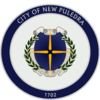New Puledra City
| New Puledra City | |
| Capital City | |
| 300px | |
| | |
 |

|
| Flag | Coat of Arms |
| | |
| Motto | dictum factum |
| City Anthem | A New Future |
| | |
| Country | |
| Entity | |
| Established | 1702 |
| | |
| Supreme Councillor | Arrowhead Winsmark 15px |
| Legislature | Central Council |
| | |
| Population | 7,244,520 City 9,010,998 Metropolitan Area |
| ISO | MI-NPC |
| Postal code | 50020 - xx |
| Website | http://www.npc.gov.mea/ |
New Puledra City, officially named as New Puledra, Federal District, is the Federal District, capital of Montesardo-East Adanzi and the seat of powers of the Montesardi Republic. The Federal District is not considered part of the provincial union, but instead, considered part of the federal territory, superseding the power it holds. The city is the second largest, most important administrative, cultural and formerly financial city (now Trotskivna) in the country.
In the efforts of granting the city more autonomy, the city had a local government founded, headed by a Supreme Councilor and a unilateral council. Ever since the 1973 Socialist Coup, the city of New Puledra has been governed by the SNM, but a rise in power has made the city more influenced by ecologists movements, making the city one of the cleanest in the country.
Contents
History
Arnouza Period
The city was originally an old military fort that was constructed to protect smaller settlements in the Montesardi plains. Increased raids from Fillician bandits and nomads led the smaller settlements to fall, seeking refuge in Fort Puledra. The strategic position of the fort allowed that the refugees remained unharmed from the attacks, eventually reducing the number of attacks against the colonists. Seeing the success in defence, newer pioneers began migrating near the fort, eventually with Duke Platino declaring it a settlement in 1702.
The settlers began building Catastros Castle on top of Mount Have, where the structure can still be observed today. This was done to avoid further raids on the sensitive parts of the cities, and to ensure that the raiders be deterred from invading. In some degree, the effort was successful, many ponies now confidently residing within the settlement. The raids stopped in 1727, with the increased presence of a local militia to defend against the attacks.
Unification Era
After the Montesardi nation was reunited in 1886, the city became the centre point and administrative hub of the Central Republic while the Kingdom of Montesardo was formed. The local administration of the area eventually held official power over the modern political divisions of Cazana, the Federal District and Northern Jansylvane as the outbreak of war initiated in 1887. The city was regarded as the most fortified and military competent areas out of the region, allowing to the larger influx of migrants into the city.
Nearing the wars end, the city fell under siege of Fillician Confederacy forces. In a last attempt to defend the city, Central Army forces under the command of General Diamond Ambegetti were ordered to hold the lines in Catastros Palace against the forces. The famed story of General Diamond and her 4000 few against the outnumbering Fillicians has given the city a unique culture in the aspect of defence, being home of the most important military base and academies the nation has. The Fillicians managed to successfully occupy the city temporarily, until the Treaty of Almendrados was signed weeks later, ending the occupation earlier than expected.
Despite having suffered direct invasion in 1891, most of the city was protected by a magical aura that ensured most of what was covered remained unscathed from artillery attacks. Its inhabitants soon set out to work on reconstruction of the former capital of the Central Republic while the statesmen of the nation reorganised the young stateless areas. The city, being significantly more wealthy and populous than the rest meant that it was the head of the new reorganising efforts done by the remaining armies and commanders. However, it wasn't until 1896 when New Puledra City officially became the national capital of the newborn Montesardi Republic.
20th Century and Current
Geography
Politics
Government
Administrative Districts
Currently, New Puledra City is divided into five districts to ease the administration. These districts are headed by Sub-Councillors, who obey what the Supreme Councillor orders. The Sub-Councillor holds little administrative privileges, only appointed to watch over the district and to report occurrences.
Diamond Island
The most populous of all the districts, Diamond Island is where the most important governmental and commercial centres may be found. The district is also known for its numerous cultural locations, such as the National Centre of Fine Arts, the Montesardi Jazz Club and the Grand Imperial Parkway among many other locations. Civilians from Diamond Island are also coined for having a distinct accent and personality, compared to other districts. Federalismo Tower is also found here, now housing foreign embassies.
Fromdesto
Also regarded as Coltford Heights, Fromdesto is where the National Office of Intelligence headquarters is located, and where the Catastros Bridge ends. This part of the city was more known for warehouses and other industrial processes, up until 1923, when these were relocated to Sarleón.
Catastros
The oldest out of all the districts, Catastros is known for the prominent Castastros Palace, a colonial fortification that was also the last defence of the Central Republic during the War of Union. The area is mostly low to mid density residential buildings with few commercial ones. The Montesardi Prime Minister's official residence, Perskovan Palace, is located in the uppermost part of Catastros, nearby the fortification. The Catastros Bridge also begins here.
Sarleón
The Diamond Bay's trade always falls into the Sarleón Harbour. Being one of the busiest districts of the city, Sarleón has an interesting combination of cultures and personalities. Historically, after the fall of Evengard, many pegasi and earth ponies migrated to the area.
Parisna-Convexión
Transportation
The large metropolitan mass has recently convinced more and more of its inhabitants to rely on a public transportation network. In response, the city government has created an extensive and city-wide network via a subway and bus network.
Air
The city has by far one of the largest airport in the nation, Diamante Ambegetti International Airport, that deals with up to two million passengers annually. Flights range from cargo to passenger flights arriving into the nation, or for flights inbound to other neighbouring nations. In order to cope with traffic, the nation is planning an extension of terminals for the airport by 2017.
Metro
Currently, the city maintains five metro lines running from edge to edge of the city. In terms of size, it is regarded as the second largest network in the nation, fully administrated by the Ministry of Public Infrastructure. The five lines deal with roughly 300,000 passengers per day, being relatively efficient and with minor delays.
Highway system
The city has a massive highway system that was built to deal with the surges of traffic that occur within rush hours. The highway system is regarded as essential for navigation within the city and beyond it, connecting all the districts with the extensives lines and roadways. The Federal Highway system starts officialy in New Puledra City in the Catastros Bridge, afterwards heading all the way to Monte Adamio, Nevarro. Counting with such infrastructure has allowed that the city count with few traffic problems via the commonly called periféricos.
